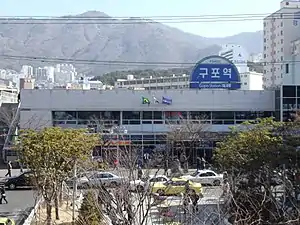| |||||||||||
|---|---|---|---|---|---|---|---|---|---|---|---|
 Station building | |||||||||||
| Korean name | |||||||||||
| Hangul | |||||||||||
| Hanja | |||||||||||
| Revised Romanization | Gupoyeok | ||||||||||
| McCune–Reischauer | Kup'oyŏk | ||||||||||
| General information | |||||||||||
| Location | Gupo-dong, Buk District, Busan South Korea | ||||||||||
| Coordinates | 35°12′16.60″N 128°59′47.61″E / 35.2046111°N 128.9965583°E | ||||||||||
| Operated by | |||||||||||
| Line(s) | Gyeongbu Line | ||||||||||
| Platforms | 2 | ||||||||||
| Tracks | 4 | ||||||||||
| Construction | |||||||||||
| Structure type | Aboveground | ||||||||||
| History | |||||||||||
| Opened | January 1, 1905 | ||||||||||
| Services | |||||||||||
| |||||||||||
Gupo station is a Korail station on the Gyeongbu Line, between Hwamyeong station and Sasang station, located in northern Busan, South Korea. It was opened on 1 January 1905, and is connected with the subway Gupo station on Busan Metro Line 3 via an overhead bridge, so passengers can transfer.[1]
On January 1, 1905, the operation was started as a temporary-operation station. It was adjusted to the office building in 1991 and began operating the KTX in 2004. KTX, ITX-Saemaeul and Mugunghwa-ho trains run and are in charge of passenger and ticket sales.[2]
History
- January 1, 1905: Start of operation as a driving station
- December 30, 1985: Present history completion
- August 16, 1989: The east–west transit train (Gupo–Haeundae) passenger handling began
- January 7, 1991: Coordinated to the officer's office
- December 2, 2002: Abolished the east–west transit railway
- April 1, 2004: KTX stopping
- November 15, 2006: Stop handling cargo handling[3]
See also
References
This article is issued from Wikipedia. The text is licensed under Creative Commons - Attribution - Sharealike. Additional terms may apply for the media files.